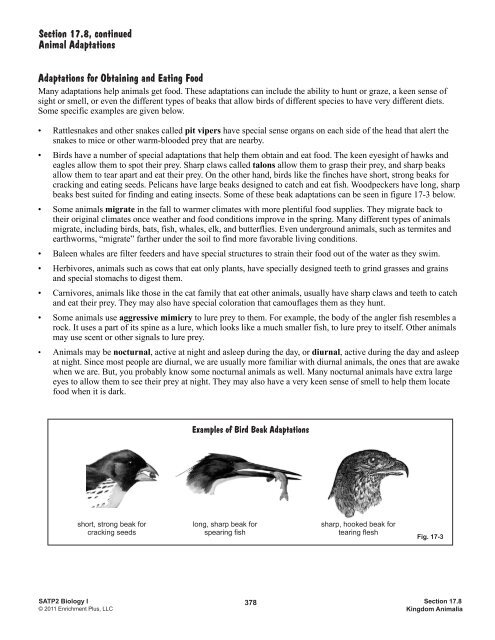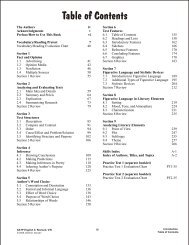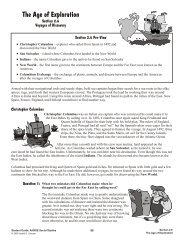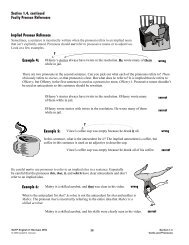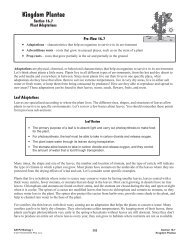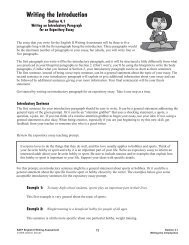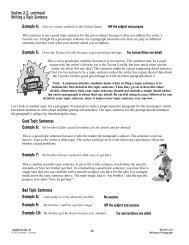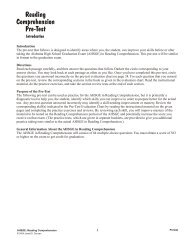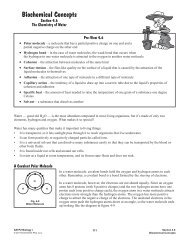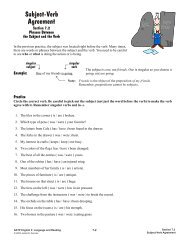Mississippi SATP2 Biology I Student Review Guide - Enrichment Plus
Mississippi SATP2 Biology I Student Review Guide - Enrichment Plus
Mississippi SATP2 Biology I Student Review Guide - Enrichment Plus
You also want an ePaper? Increase the reach of your titles
YUMPU automatically turns print PDFs into web optimized ePapers that Google loves.
Section 17.8, continued<br />
Animal Adaptations<br />
Adaptations for Obtaining and Eating Food<br />
Many adaptations help animals get food. These adaptations can include the ability to hunt or graze, a keen sense of<br />
sight or smell, or even the different types of beaks that allow birds of different species to have very different diets.<br />
Some specific examples are given below.<br />
• Rattlesnakes and other snakes called pit vipers have special sense organs on each side of the head that alert the<br />
snakes to mice or other warm-blooded prey that are nearby.<br />
• Birds have a number of special adaptations that help them obtain and eat food. The keen eyesight of hawks and<br />
eagles allow them to spot their prey. Sharp claws called talons allow them to grasp their prey, and sharp beaks<br />
allow them to tear apart and eat their prey. On the other hand, birds like the finches have short, strong beaks for<br />
cracking and eating seeds. Pelicans have large beaks designed to catch and eat fish. Woodpeckers have long, sharp<br />
beaks best suited for finding and eating insects. Some of these beak adaptations can be seen in figure 17-3 below.<br />
• Some animals migrate in the fall to warmer climates with more plentiful food supplies. They migrate back to<br />
their original climates once weather and food conditions improve in the spring. Many different types of animals<br />
migrate, including birds, bats, fish, whales, elk, and butterflies. Even underground animals, such as termites and<br />
earthworms, “migrate” farther under the soil to find more favorable living conditions.<br />
• Baleen whales are filter feeders and have special structures to strain their food out of the water as they swim.<br />
• Herbivores, animals such as cows that eat only plants, have specially designed teeth to grind grasses and grains<br />
and special stomachs to digest them.<br />
• Carnivores, animals like those in the cat family that eat other animals, usually have sharp claws and teeth to catch<br />
and eat their prey. They may also have special coloration that camouflages them as they hunt.<br />
• Some animals use aggressive mimicry to lure prey to them. For example, the body of the angler fish resembles a<br />
rock. It uses a part of its spine as a lure, which looks like a much smaller fish, to lure prey to itself. Other animals<br />
may use scent or other signals to lure prey.<br />
• Animals may be nocturnal, active at night and asleep during the day, or diurnal, active during the day and asleep<br />
at night. Since most people are diurnal, we are usually more familiar with diurnal animals, the ones that are awake<br />
when we are. But, you probably know some nocturnal animals as well. Many nocturnal animals have extra large<br />
eyes to allow them to see their prey at night. They may also have a very keen sense of smell to help them locate<br />
food when it is dark.<br />
Examples of Bird Beak Adaptations<br />
short, strong beak for<br />
cracking seeds<br />
long, sharp beak for<br />
spearing fish<br />
sharp, hooked beak for<br />
tearing flesh<br />
Fig. 17-3<br />
<strong>SATP2</strong> <strong>Biology</strong> I<br />
© 2011 <strong>Enrichment</strong> <strong>Plus</strong>, LLC<br />
378<br />
Section 17.8<br />
Kingdom Animalia


